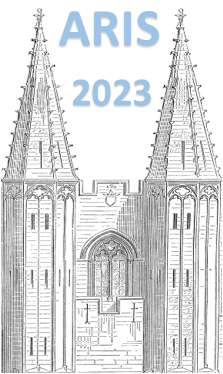Orateur
Description
Nuclei along N=20 provide an excellent region to investigate the change in nuclear structure and interactions. From their evolution from the doubly magic nucleus $^{40}$Ca through to the Z=16 and Z=14 nuclei $^{36}$S and $^{34}$Si, respectively, to $^{32}$Mg with a deformed $2p-2h$ intruder ground state [1]. The mechanism responsible for the change in shell structure is not well understood and is suspected to be a subtle combination of the different components of the nuclear force namely the central, spin-orbit (SO), and tensor parts. A significant reduction of the neutron $d_{5/2}$ and $d_{3/2}$ spin-orbit splitting between $^{40}$Ca and $^{36}$S, as protons are removed from the $d_{3/2}$ orbital, would be indicative of the proton-neutron tensor force. By comparing the neutron $d_{5/2}$ hole strength between these nuclei, the strength of the tensor force is probed in an unprecedented manner.
The centroids of the hole states in $^{35}$S have been inferred from a $^{36}$S(p,d)$^{35}$S experiment performed at iThemba LABS. A $^{36}$S(p,d)$^{35}$S reaction is a useful tool to probe the neutron spin-orbit splitting in $^{36}$S, provided a reliable $^{36}$S target is available. This was achieved by specifically developing a new target system at iThemba LABS which allows for a cost-effective $^{36}$S target without heavy contaminants to be used. This novel target encapsulates sulfur between two Mylar foils and has been shown to be an effective way to produce targets with a significant amount of material (0.5-1 mg/cm$^2$).
Using this moving $^{36}$S target with 66 MeV incident protons, states in $^{35}$S were measured with the K600 magnetic spectrometer at iThemba LABS. States up to 20 MeV were observed, identifying the neutron single-particle strength below and above the Fermi surface using the detection of the deuterons at the focal plane of the K600 spectrometer with an energy resolution of approximately 30 keV [2]. The results from the $^{36}$S(p,d)$^{35}$S experiment were compared to the $^{40}$Ca(p,d)$^{39}$Ca study by Matoba et al. [3]. The results show an increase of the neutron $1d_{5/2}$ - $1d_{3/2}$ SO
splitting between $^{35}$S and $^{39}$Ca by 0.411 MeV. This is contrary to the universal trend of SO splitting with increasing mass number which would predict a decrease of $\sim$ 0.450 MeV. This deviation is highly indicative of the effect of tensor forces. At present, the tensor force is not implemented in the vast majority of the available mean field and relativistic mean field calculations, whereby the amplitude of the SO
splitting is solely attributed to the spin-orbit force. This study provides an unambiguous result indicating the role of the tensor force. It is shown that the strength of the tensor force is, however, lower than predicted by the shell model and ab-initio theory.
[1] O. Sorlin and M.-G. Porquet, Progress in Particle and Nuclear Physics 61,
602 (2008), ISSN 0146-6410
[2] R. Neveling, H. Fujita, et. al Nuclear Instruments and Methods in Physics Research Section A: Accelerators, Spectrometers, Detectors and
Associated Equipment 654, 29 (2011), ISSN 0168-9002
[3] M. Matoba, et. al Phys. Rev. C 48, 95 (1993)
This work is supported by the National Research Foundation of South Africa grant 118846.

